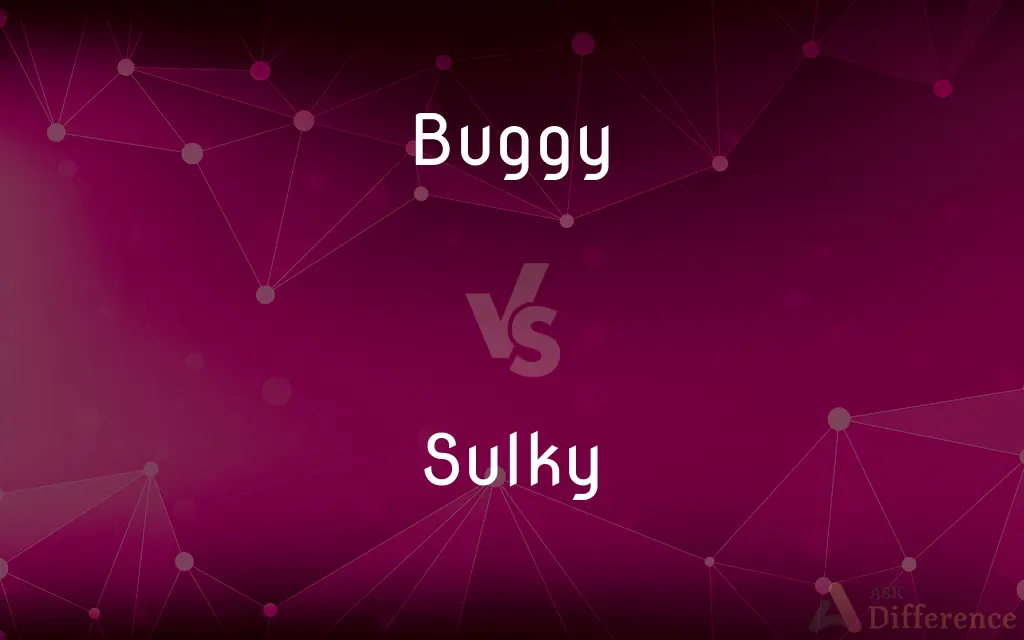Buggy vs. Sulky — What's the Difference?
By Tayyaba Rehman & Fiza Rafique — Updated on April 6, 2024
A buggy is a lightweight carriage with four wheels, used for leisurely rides, whereas a sulky is a light, two-wheeled cart for one person, often used in harness racing.

Difference Between Buggy and Sulky
Table of Contents
ADVERTISEMENT
Key Differences
Buggies are known for their four-wheel design, offering stability and space, typically used for leisurely rides or as utility vehicles in rural areas. They can accommodate multiple passengers and are often drawn by one or more horses. On the other hand, a sulky is a two-wheeled vehicle designed primarily for single-person use, most commonly seen in the context of horse racing, particularly harness racing. It is designed to minimize weight and air resistance to maximize the horse's speed.
The design of a buggy emphasizes comfort and utility, with features like a canopy or cover for protection against the elements, making it suitable for casual, recreational use or transport. Sulkies, however, focus on speed and minimalism, with a very lightweight frame that leaves the driver exposed to the environment, which is ideal for competitive racing.
In terms of usage, buggies are versatile; they can be used for a wide range of purposes, from transporting goods to leisurely carriage rides through parks or rural landscapes. Sulkies are specifically built for the sport of harness racing, where a horse, typically a standardbred, trots or paces while pulling the sulky and its driver around a track.
Buggies hold a historical significance in many parts of the world, often associated with a bygone era of transport before the advent of automobiles. Sulkies, while also historic, are more niche, primarily associated with the equestrian sports community, highlighting a different aspect of human-horse interaction.
Comparison Chart
Number of Wheels
Four
Two
ADVERTISEMENT
Usage
Leisure, transport
Racing
Capacity
Multiple passengers
Single driver
Design Focus
Comfort, stability
Speed, minimalism
Cultural Significance
Historical, broader transport role
Niche, equestrian sports
Compare with Definitions
Buggy
In modern contexts, a buggy can refer to an off-road or lightweight vehicle.
They rented a dune buggy for their desert adventure.
Sulky
A lightweight, two-wheeled cart designed for a single occupant, often used in harness racing.
The racer harnessed his horse to the sulky for the upcoming competition.
Buggy
A small carriage or cart, often with four wheels, designed for carrying people.
They took a leisurely ride in the park with a horse-drawn buggy.
Sulky
Sulkies are part of the equipment in standardbred horse racing.
Standardbred horses are trained to race at a trot or pace while pulling a sulky.
Buggy
Historically, a buggy was a primary means of family transport in rural areas.
The family loaded their belongings into the buggy for the trip to town.
Sulky
Sulkies have evolved with technology, incorporating materials like carbon fiber.
The new carbon fiber sulky offers improved speed and durability.
Buggy
A buggy may also be used in a recreational or touristic context.
The tour guide offered buggy rides around the historic estate.
Sulky
The sulky allows for high-speed, competitive racing due to its aerodynamic design.
The sulky's sleek design contributed to their victory in the race.
Buggy
In some regions, buggies are synonymous with Amish or Mennonite transport.
Amish buggies are a common sight on the roads of Lancaster County.
Sulky
The design of a sulky focuses on minimizing resistance and weight.
Modern sulkies use advanced materials for lightweight and strength.
Buggy
A small motor vehicle, typically with an open top
A golf buggy
Sulky
A sulky is a lightweight cart with two wheels and a seat for the driver only but usually without a body, generally pulled by horses or dogs, which is used for harness races. The term is also used for a light stroller, an arch mounted on wheels or crawler tracks, used in logging, or other types of vehicle having wheels and usually a seat for the driver, such as a plough, lister or cultivator.
Buggy
A light folding chair on wheels, in which a baby or young child can be pushed along
Her two younger children were in a buggy
Sulky
Sullenly aloof or withdrawn, especially in response to having had one's will thwarted.
Buggy
Infested with bugs.
Sulky
Gloomy; dismal
Sulky weather.
Buggy
(of a computer program or system) faulty in operation.
Sulky
A light, open two-wheeled vehicle accommodating only the driver and drawn by one horse, used especially in harness racing.
Buggy
Mad; insane.
Sulky
Silent and withdrawn after being upset
The sulky child
Buggy
A small, light, one-horse carriage usually having four wheels in the United States and two wheels in Great Britain.
Sulky
A low two-wheeled cart, used in harness racing.
Buggy
A baby carriage.
Sulky
Any carriage seating only the driver.
Buggy
A passenger or recreational vehicle, usually with oversized tires, designed for off-road use.
Sulky
Moodly silent; sullen; sour; obstinate; morose; splenetic.
Buggy
(Informal) An automobile.
Sulky
A light two-wheeled carriage for a single person.
Buggy
Chiefly Southern US A shopping cart, especially for groceries.
Sulky
A light two-wheeled vehicle for one person; drawn by one horse
Buggy
Infested with bugs.
Sulky
Sullen or moody
Buggy
(Computers) Having many software bugs
A buggy program.
Buggy
(Slang) Crazy.
Buggy
A small horse-drawn cart.
Buggy
A small motor vehicle, such as a dune buggy.
Buggy
A hearse.
Buggy
A pushchair; a stroller.
Buggy
A shopping cart or trolley.
Buggy
With insects.
Buggy
(computing) Containing programming errors.
This software is so buggy that I don't know how anyone can use it!
Buggy
Resembling an insect.
Buggy
(slang) crazy; bughouse.
Buggy
Infested or abounding with bugs.
Buggy
A light one horse two-wheeled vehicle.
Villebeck prevailed upon Flora to drive with him to the race in a buggy.
Buggy
A light, four-wheeled vehicle, usually with one seat, and with or without a calash top.
Buggy
A small lightweight carriage; drawn by a single horse
Buggy
Informal or slang terms for mentally irregular;
It used to drive my husband balmy
Buggy
Infested with bugs
Common Curiosities
What is a sulky?
A sulky is a lightweight, two-wheeled cart for one person, primarily used in harness racing.
For what purposes are buggies used?
Buggies are used for leisure, transport, and in some areas as part of cultural practices.
Can buggies carry more than one person?
Yes, buggies can accommodate multiple passengers.
What is a buggy?
A buggy is a four-wheeled carriage designed for leisurely rides, often pulled by horses.
How many wheels does a buggy have compared to a sulky?
A buggy has four wheels, while a sulky has two.
What is emphasized in the design of a sulky?
The design of a sulky emphasizes speed and minimalism.
What is the primary use of a sulky?
Sulkies are primarily used for harness racing.
What is the focus in the design of a buggy?
The design of a buggy focuses on comfort and stability.
Is a sulky designed for more than one person?
No, a sulky is designed for just one person, the driver.
What materials are used in modern sulkies?
Modern sulkies often use lightweight and strong materials like carbon fiber.
Do buggies have any historical significance?
Yes, buggies have historical significance as a form of transport before the widespread adoption of automobiles.
Are buggies still used today?
Yes, buggies are still used today, particularly in areas with Amish and Mennonite communities and for recreational purposes.
Is a sulky only used for racing?
Primarily, yes, sulkies are designed and used for harness racing.
Are sulkies and buggies used in the same contexts?
No, buggies are versatile and used in various contexts, while sulkies are specialized for competitive harness racing.
How has the design of sulkies evolved?
The design of sulkies has evolved to incorporate advanced materials and aerodynamics for racing efficiency.
Share Your Discovery

Previous Comparison
Circle vs. Circuit
Next Comparison
Illustration vs. ShowAuthor Spotlight
Written by
Tayyaba RehmanTayyaba Rehman is a distinguished writer, currently serving as a primary contributor to askdifference.com. As a researcher in semantics and etymology, Tayyaba's passion for the complexity of languages and their distinctions has found a perfect home on the platform. Tayyaba delves into the intricacies of language, distinguishing between commonly confused words and phrases, thereby providing clarity for readers worldwide.
Co-written by
Fiza RafiqueFiza Rafique is a skilled content writer at AskDifference.com, where she meticulously refines and enhances written pieces. Drawing from her vast editorial expertise, Fiza ensures clarity, accuracy, and precision in every article. Passionate about language, she continually seeks to elevate the quality of content for readers worldwide.
















































